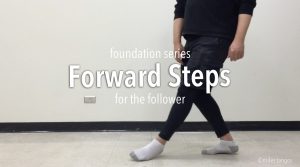Argentine Cross
The ‘goto’ move in most beginners, and later on a ubiquitous figure and staple of the dance. This is steps 2 thru 5 of the Basic 8. Which can be done in Open or Close Embrace, at any point of the dance.
The ‘goto’ move in most beginners, and later on a ubiquitous figure and staple of the dance. This is steps 2 thru 5 of the Basic 8. Which can be done in Open or Close Embrace, at any point of the dance.
The word itself, from a Tango perspective, typically has come to refer to an idea of balance, or sometimes one’s equilibrium. Usually when this word is used it’s used as a way to describe someone’s inability to be stable when walking or in a movement. Sometimes it refers to someone’s
Tango Floorcraft refers to a whole cadre of practices, relationships, and awarenesses that we have to be fully cognizant of in order to dance argentine tango as a Lead or as a Follow. Primarily it deals with spacing between the couples and the maintenance of that space at all times.

Follower Forward Steps. For a Follower, this type of walking step only happens 4 times in the dance. In Forward Ochos (and it’s variations), the Ocho Cortado (and it’s variations), the Follower’s Molinete (not the Milonguero Turn), all Calesitas and Walking Turns, and lastly Milonga! This is an important step
Apilado (pron: Ahh-Pee-Lah-Do), sometimes you will see this word spelled as ‘Apillado‘ and pronounced as Ahhh-Pee-Sha-Do. They mean the same things. The latter is a bastardized – ahem, Argentine version of the word. In short, this word is the past participle of the verb ‘Apilar’ which means ‘to pile up’ or ‘to put in
Follower Technique. This is quite possibly the single most important thing that a Follower can do for themselves, to study how to take their 3 most important steps, Foward, Side, and Back. Usually Follower technique only covers these items. However, in recent years it has grown to cover and certain
Why Should You Signup ? The simplest reason is that you won’t find this stuff anywhere else. It’s a different kind of tango education. It will help you to understand what you want, how to do it, and why you want to do things with Intention in mind. It will show you how to listen to the music, and how to create different types of vocabulary, as well as how to engage in the milonga environment. This site is all about showing you a better pathway towards a type of tango that reinforces the ideas of Social Tango thru Intention Based Dancing.